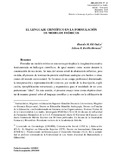| dc.rights.license | http://creativecommons.org/licenses/by-nc-sa/3.0/ve/ | es_VE |
| dc.contributor.author | Gil Otaiza, Ricardo | |
| dc.contributor.author | Revilla Herman, Edison R | |
| dc.date.accessioned | 2019-01-21T17:13:24Z | |
| dc.date.available | 2019-01-21T17:13:24Z | |
| dc.date.issued | 2018 | |
| dc.identifier.issn | 1316-7939 | |
| dc.identifier.uri | http://www.saber.ula.ve/handle/123456789/45615 | |
| dc.description.abstract | Formular un modelo teórico es una tarea que implica la imaginación creativa fundamentada en hallazgos científicos, de igual manera como ocurre durante la construcción de una teoría. Se trata del mismo nivel de abstracción reflexivo, pero en ésta, el proceso de teorización permite establecer analogías con hechos o situa-ciones del mundo socio-natural. Se favorece en un campo profesional determinado, la interpretación y representación del contexto, por medio de la descripción, expli-cación, ejemplificación estructurada y esquemática para el modelado de un com-portamiento “ideal”. En este sentido, el presente ensayo tiene como objetivo diser-tar de manera general sobre el lenguaje científico y su empleo en la edificación de un modelo teórico, conociendo sus características distintivas, proceso de formula-ción y aplicaciones a partir de la examinación de algunos aspectos fundamentales del discurso académico, pero todo ello, conducido hacia el abordaje del “modelo teórico”, partiendo del concepto general de modelo, características, tipos y proceso de elaboración, a través de una serie de ejemplos propuestos por especialistas de las ciencias humanas y sociales. | es_VE |
| dc.language.iso | es | es_VE |
| dc.publisher | SaberULA | es_VE |
| dc.rights | info:eu-repo/semantics/openAccess | es_VE |
| dc.subject | Lenguaje científico | es_VE |
| dc.subject | Formulación | es_VE |
| dc.subject | Teorización | es_VE |
| dc.subject | Abstracción científica | es_VE |
| dc.subject | Modelo teórico | es_VE |
| dc.title | El lenguaje científico en la formulación de modelos teóricos | es_VE |
| dc.title.alternative | Scientific language in the formulation of theoretical models | es_VE |
| dc.type | info:eu-repo/semantics/article | es_VE |
| dcterms.dateAccepted | 29/6/2018 | |
| dcterms.dateSubmitted | 15/5/2018 | |
| dc.description.abstract1 | Formulating a theoretical model is a task that involves the creative imagina-tion based on scientific findings, just as it happens during the construction of a theory. It is the same level of reflexive abstraction, but in this, the process of theo-rization allows to establish analogies with facts or situations of the socio-natural world. The interpretation and representation of the context is favored in a given professional field, by means of the description, explanation, structured and sche-matic exemplification for the modeling of an "ideal" behavior. In this sense, the present essay aims to give a general explanation of the scientific language and its use in the construction of a theoretical model, knowing its distinctive characteris-tics, formulation process and applications from the examination of some funda-mental aspects of discourse academic, but all this, driven towards the approach of the "theoretical model", starting from the general concept of model, characteristics, types and process of elaboration, through a series of examples proposed by special-ists of the human and social sciences. | es_VE |
| dc.description.colacion | 161-193 | es_VE |
| dc.description.frecuencia | anual | |
| dc.identifier.depositolegal | 199802ME321 | |
| dc.publisher.pais | Venezuela | es_VE |
| dc.subject.centroinvestigacion | Centro de Investigaciones Jurídicas (CIJ) | |
| dc.subject.facultad | Facultad de Ciencias Jurídicas y Políticas | es_VE |
| dc.subject.institucion | Universidad de Los Andes | es_VE |
| dc.subject.keywords | Scientific language | es_VE |
| dc.subject.keywords | Formulation | es_VE |
| dc.subject.keywords | Theorization | es_VE |
| dc.subject.keywords | Scientific abstrac-tion | es_VE |
| dc.subject.keywords | Theoretical model | es_VE |
| dc.subject.publicacionelectronica | Revista Dikaiosyne | |
| dc.subject.seccion | Revista Dikaiosyne: Interdisciplinares | es_VE |
| dc.subject.thematiccategory | Ciencias Jurídicas y Políticas | es_VE |
| dc.subject.tipo | Revistas | es_VE |
| dc.type.media | Texto | es_VE |


